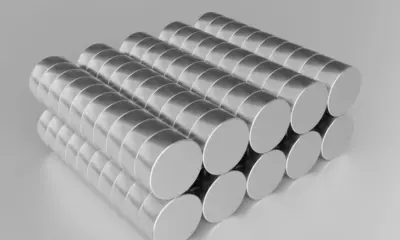Science
Researchers Uncover Unusual Quantum Oscillations in Insulating Material

Researchers at the University of Michigan have made a groundbreaking discovery regarding quantum oscillations within an insulating material, challenging long-standing assumptions in physics. This study, published on November 9, 2025, in Physical Review Letters, indicates that these oscillations emerge from the material’s bulk rather than solely from its surface. This finding hints at a novel duality in materials science, suggesting that certain compounds might exhibit both metallic and insulating properties, posing intriguing questions for future research.
The research, conducted in collaboration with an international team at the National Magnetic Field Laboratory, was funded by the U.S. National Science Foundation and the U.S. Department of Energy. Lead researcher Lu Li, a physicist specializing in advanced materials, noted the extraordinary nature of their findings. “I would love to claim that there’s a great application, but my work keeps pushing that dream further away,” he remarked. “But what we’ve found is still really bizarre and exciting.”
Understanding Quantum Oscillations
Quantum oscillations typically occur in metals, where electrons behave akin to tiny springs. When subjected to magnetic fields, these electrons vibrate, and by modifying the strength of the magnetic field, scientists can influence the rate at which these oscillations occur. Recently, researchers identified similar oscillations in insulators, materials that should not conduct electricity or heat. This revelation sparked debate in the scientific community about the origin of these oscillations—whether they are surface effects or arise from within the material.
Li and his team utilized the powerful magnets at the National Magnetic Field Laboratory to investigate this phenomenon. Their experiments confirmed that the oscillations originate not from the surface, but from the bulk of the material itself. “I wish I knew what to do with that, but at this stage we have no idea,” Li admitted. “What we have right now is experimental evidence of a remarkable phenomenon.”
A Collaborative Effort Yielding New Insights
The study brought together over a dozen scientists from six institutions across the United States and Japan, including research fellow Kuan-Wen Chen and graduate students Yuan Zhu, Guoxin Zheng, Dechen Zhang, Aaron Chan, and Kaila Jenkins from the University of Michigan. Chen expressed enthusiasm about the findings, stating, “For years, scientists have pursued the answer to a fundamental question about the carrier origin in this exotic insulator: Is it from the bulk or the surface, intrinsic or extrinsic? We are excited to provide clear evidence that it is bulk and intrinsic.”
Li further elaborated on this discovery as part of a “new duality” in physics. Traditionally, duality in physics has been understood through the lens of light and matter behaving as both waves and particles. The new aspect involves materials that can function both as conductors and insulators. The research team investigated this concept using a compound known as ytterbium boride (YbB12) under an exceptionally powerful magnetic field, reaching up to 35 Tesla—approximately 35 times stronger than the magnetic field in a typical hospital MRI machine.
“Effectively, we’re showing that this naive picture where we envisioned a surface with good conduction that’s feasible to use in electronics is completely wrong,” Li explained. “It’s the whole compound that behaves like a metal even though it’s an insulator.”
The implications of this “metal-like” behavior, although only observable under extreme magnetic conditions, raise profound questions about material behavior at the quantum level. Zhu remarked on the excitement of confirming that the oscillations are both bulk and intrinsic, highlighting the need for further investigations to understand the neutral particles responsible for these observations.
This project received additional support from the Institute for Complex Adaptive Matter, the Gordon and Betty Moore Foundation, the Japan Society for the Promotion of Science, and the Japan Science and Technology Agency. The researchers hope their findings will inspire additional experiments and theoretical exploration in this fascinating area of materials science.
-

 Top Stories2 weeks ago
Top Stories2 weeks agoMarc Buoniconti’s Legacy: 40 Years Later, Lives Transformed
-

 Health2 weeks ago
Health2 weeks agoInnovative Surgery Restores Confidence for Breast Cancer Patients
-

 Sports4 weeks ago
Sports4 weeks agoSteve Kerr Supports Jonathan Kuminga After Ejection in Preseason Game
-

 Science4 weeks ago
Science4 weeks agoChicago’s Viral ‘Rat Hole’ Likely Created by Squirrel, Study Reveals
-

 Entertainment4 weeks ago
Entertainment4 weeks agoZoe Saldana Advocates for James Cameron’s Avatar Documentary
-

 Business4 weeks ago
Business4 weeks agoTyler Technologies Set to Reveal Q3 2025 Earnings on October 22
-

 Politics4 weeks ago
Politics4 weeks agoDallin H. Oaks Assumes Leadership of Latter-day Saints Church
-

 Business3 weeks ago
Business3 weeks agoZacks Research Downgrades Equinox Gold to Strong Sell Rating
-

 Lifestyle4 weeks ago
Lifestyle4 weeks agoKelsea Ballerini Launches ‘Burn the Baggage’ Candle with Ranger Station
-

 Health2 weeks ago
Health2 weeks ago13-Year-Old Hospitalized After Swallowing 100 Magnets
-

 Health4 weeks ago
Health4 weeks agoCommunity Unites for Seventh Annual Mental Health Awareness Walk
-

 Business3 weeks ago
Business3 weeks agoBusiness Schools Urged to Prioritize Economic Freedom Education









